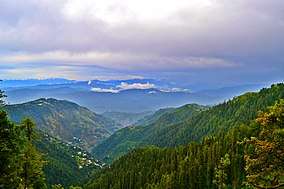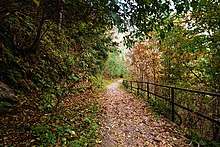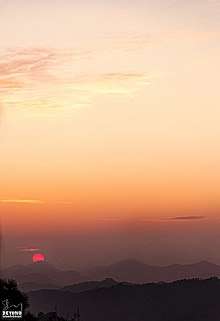Ayubia National Park
Ayubia National Park (Urdu: ایوبیہ ملی باغ), also known as Ayubia (Urdu: ایوبیہ), is a protected area of 3,312 hectares (33 km2)[1] located in Abbottabad District, Khyber Pakhtunkhwa province, Pakistan. It was declared a national park in 1984.[2] Ayubia was named after Muhammad Ayub Khan (1958–1969), second President of Pakistan. The area supports temperate coniferous forest and temperate broadleaf and mixed forest ecoregion habitats, with an average elevation of 8,000 feet (2,400 m) above sea level.[3] Ayubia National Park is surrounded by seven major villages and three small towns of Thandiani, Nathiagali and Khanspur.[4] The park has been developed as a resort complex from a combination of four mini resorts of Khaira Gali, Changla Gali, Khanspur and Ghora Dhaka in Galyat.[5] Currently, it is managed by the Wildlife and Parks Department of Government of Khyber Pakhtunkhwa.
| Ayubia National Park ایوبیہ ملی باغ | |
|---|---|
IUCN category V (protected landscape/seascape) | |
 A view of Ayubia's pine forests | |
 | |
| Location | Abbottabad, Pakistan |
| Coordinates | 33°51′54.83″N 73°8′19.57″E |
| Area | 33.12 km2 (12.79 sq mi) |
| Elevation | 8,000 ft (2,400 m) |
| Established | 1984 |
| Visitors | 250000 |
| Governing body | Wildlife and Parks Department, Government of Khyber Pakhtunkhwa |

History
Ayubia National Park was established in 1984 in an east corner of Khyber Pakhtunkhwa province of Pakistan. In 1998 it was expanded form its original size of 1,684 hectares (4,161 acres)[6] or 16.84 km2 (6.50 sq mi) to 3,312 hectares (8,184 acres). Since then it has been managed by the Khyber Pakhtunkhwa Wildlife Department. The purpose of establishing it was to conserve the temperate forests. Originally, the park stood at an area of 857 acres (3.47 km2), but in 1998 it was expanded to cover an area of 1,685 acres (6.82 km2).
The total population of Ayubia and surrounding villages as per a 1996 census is 18,097 people living in 2,311 households.
Climate

The climate of the park is cool in the summers, but harsh in the winters. While it remains only placidly hot in May and June, the cold sets in when the monsoons come to lash in late July and early August. In the winters cold increases in severity gradually until the west winds bring rains, which eventually turn into snow. The park remains snow-capped through the later part of winters.
Wildlife
The park holds 104 species of plants. The main floral species are Cedrus deodara, blue pine, yew, silver fir, horse chestnut and oak. Around 21 plants belonging to 19 families are known for their medicinal properties. Many of these are used in treatment of jaundice, stomach ulcers, snake bites, internal infections, diabetes, psoriasis and more. Some plants are said to have anti-carcinogenic effect as well. Also, some are used as biological insecticides and pesticides, mostly due to their insect-repellent nature. The World Wide Fund for Nature has launched an ethno-botanical initiative here "to demonstrate the sustainable use of plant resources as a means for protecting biodiversity." The park harbors up to 203 species of birds. Many species of birds, including the golden eagle, the vulture, Eurasian sparrowhawk and the hill pigeon among others can be found here. It is also home to some of the rarer Himalayan pheasant species like the kalij and koklass pheasants. Ayubia National Park supports 31 species of mammals such as the Indian leopard, hill fox and flying squirrel.
Among reptiles and amphibians, Kashmir Rock Agama, Striped Grass Skink and Himalayan Pit Viper can also be encountered here.
Management
The park has been managed by Khyber Pakhtunkhwa Wildlife Department under the 1975 Khyber Pakhtunkhwa Wildlife Act. The headquarters of the park is at Dunga Gali, which is situated at a distance of 50 km from Abbottabad and 25 km from Murree.
Tourism
Standing at some 26 kilometers from the tourist hotbed of Murree Hill Station, over 100,000 tourists flock to Ayubia National Park and the places around every year. It is well known for its picnic spots.
This National Park also features the "Pipeline Walking Track" that runs from Ayubia to Nathiagali and is 4 kilometers in length.

Since there are 7 villages and 4 major towns around it, and since this area attracts a very large number of tourists annually, there is a large number of hotels and restaurants around the park. In addition to riding trails, hiking places, picnic spots and motels, there is a chairlift in Ayubia that takes the tourists to a nearby summit called Mukeshpuri for a view of the forested hills. This chairlift was the first recreation facility of its kind in Pakistan and is still a major attraction for domestic tourists. The famous PTDC motel is located here.
Gallery
 Glaciers, Mountains, Valleys & Hills.
Glaciers, Mountains, Valleys & Hills.- Track between Donga Gali and Ayubia known as Ayubia National Park track.
- A view of mountains from track between Donga Gali and Ayubia known as Ayubia National Park track.
- Cloud can be seen from track between Donga Gali and Ayubia known as Ayubia National Park track.
- Ayubia National Park track.
 Kashmir Rock Agama can be found here.
Kashmir Rock Agama can be found here.
See also
References
- Khan, Ibrahim (July 14, 2010). "Improving Sub-Watershed Management and Environmental Awareness in the Ayubia National Park". wwf.panda.org. WWF - Pakistan. Archived from the original on 1 September 2010. Retrieved September 15, 2010.
- "Country Report on Plant Genetic Resources for Food and Agriculture - Pakistan" (PDF). parc.gov.pk. Pakistan Agricultural Research Council. Archived from the original (PDF) on January 18, 2012. Retrieved September 8, 2010.
- "Ayubia National Park". tourism.gov.pk. Tourism, Government of Pakistan. Archived from the original on October 15, 2011. Retrieved September 15, 2010.
- "Ayubia National Park". wildlifeofpakistan.com. 2002. Archived from the original on 31 August 2010. Retrieved September 14, 2010.
- "Ayubia National Park". nathiagali.com. Nathiagali. Archived from the original on August 4, 2009. Retrieved September 15, 2010.
- "Review of 'Protected Areas System' in Pakistan: Present status and problems concerning future development (Page 9)" (PDF). dergiler.ankara.edu.tr. 2010. Retrieved September 8, 2010.
- "Ayubia National Park". world-wildlife-adventures.com. World Wildlife Adventures. Archived from the original on December 23, 2010. Retrieved September 15, 2010.
External links
| Wikimedia Commons has media related to Ayubia National Park. |
| Wikivoyage has a travel guide for Ayubia National Park. |